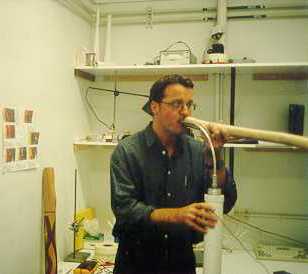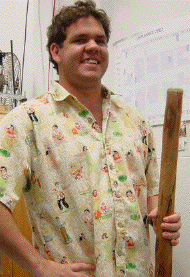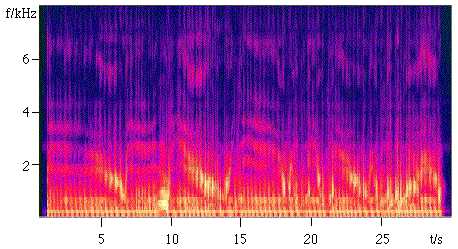Didjeridu acoustics
This page gives a brief introduction to the acoustics of the didjeridu (sometimes spelt didgeridoo, and known as yidaki or yiraki
in the language of the Yolngu, one of the peoples of Northern
Australia, where the instrument originated). The didjeridu/yidaki is a
remarkable instrument because of the wide variety of timbres that it
produces. Further, it is of more general interest because it is the
most evident example of the interaction between a wind instrument and
the vocal tract of the player. These interactions are important to good
playing of any wind instrument, but to the didjeridu they are central,
so this page concentrates on discussion them. We also use this page to
report the results of a research project, so some preliminary
scientific papers are linked below. The project involves five
researchers from three institutions:
Alex Tarnopolsky [1].Neville Fletcher[2], Lloyd Hollenberg [3],
John Smith [1] and Joe Wolfe [1].
[1] The University of New South Wales, [2]The Australian National University and [3] The University of Melbourne.
 
Lloyd Hollenberg (left), physicist and didjeridu player, managing to
play the didjeridu while having the acoustic properties of his vocal
tract measured. In the sound clip below, Lloyd demonstrates several
didjeridu effects produced by changes in the shape of the vocal tract
configuration (moving tongue and jaw) and by vocalisations (vocal fold
vibration) on top of a drone with a fundamental at 71 Hz (~C#2). Ben
Lange (right), is a student and didjeridu player who is also working on
this project.
 . . . Download didj sound file in .wmp3 format (470 k) . . . Download didj sound file in .wmp3 format (470 k)
How does such a simple instrument make such a variety of interesting sounds?
The instrument is deceptively simple: it is just a wooden tube, about
1.2 to 1.5 m long, hollowed out by termites in the thin trunk of a
eucalypt tree, and with a ring of beeswax around the mouthpiece for
sealing and player's comfort. It acts as a closed pipe,
and its shape, though irregular, is roughly that of a truncated cone,
usually with a small flare, so that it is not very different to a
cylinder. The second resonance is about a 10th or 11th higher than the
fundamental, but overblowing is not very important in most playing
techniques. Further, because the resonances usually have no harmonic
relation to each other, the instrument geometry is less important to
the sound than is the case in other wind instruments. Because the
player's lips control the air flow, it is classed as a lip-reed
instrument, as are tuba, trumpet etc. The operation of this family is
discussed in Introduction to brass acoustics.
What makes the didjeridu's sound so interesting and varied is the very strong and varied interactions among
* the sound waves in the instrument,
* the motions of the player's lips and
* the sound waves that are produced in the player's vocal tract.

A schematic diagram of the acoustic system (not to scale).
The standing sound waves in the didjeridu itself are qualitatively much
like those in other lip-reed instruments and so are understood
reasonably well. There are however considerable differences from other
lip reeds due to the rather irregular shape and surface roughness, and
to the fact that the resonant frequencies are not harmonic. The sound
waves in the player's vocal tract are strongly influenced by the
resonances of the tract itself, which are modified by the player during
performance, and to the way these resonances are excited by the regular
openings of the lips and the sound waves in the instrument. In turn,
the regular opening and closing of the lips is determined by the
difference in pressure between the air inside the lips and outside the
lips (which includes the effects of the wave in the didjeridu), along
with the pressure variations due to air flow and, of course, the
muscular tension in the lips themselves. Sometimes the sounds also
involve vocalisations--sounds made by vibrations of the player's vocal
folds, as in singing. The waves produced by the vibrations of the vocal
folds can interact with the those generated by the lip vibrations in
nonlinear ways to produce complex sounds. In short, a simple
instrument, but lots of interesting sounds--and interesting physics!
Playing the instrument requires circular breathing.
For most of the time, the player exhales through the mouth in the
ordinary way, but, when new air is needed, the cheeks are filled with
air, the soft palate is used to isolate the mouth from the respiratory
tract, and the air in the mouth is used to continue playing by
contracting the cheeks. Meanwhile, the player inhales quickly through
the nose. This requires coordination--and a lot of practice. The result
is an uninterrupted sound from the instrument. The timbre changes:
during the normal part of the cycle, the whole vocal tract is connected
via the lips to the instrument. During the inhalation, only the mouth
itself is involved. There are great differences in the resonances in
the mouth for these two configurations, so the timbre of the sound
produced changes dramatically. Far from being a disadvantage, players
use this timbre difference, along with differences in loudness, to
establish the rhythm of the performance. For more about the resonances
of the vocal tract, see our site on vocal tract acoustics.

The spectrogram of the same didjeridu sound clip linked above. A
strong formant is indicated by the patches of light colour. These are
changing with time as Lloyd changes the shape of his tract.

More to come. This project is just beginning and we shall be adding more physics, pics and sounds to this site in the future.
More detailed information on didjeridu acoustics (reproduced with kind permission of the editors).
 | Fletcher, N., Hollenberg, L., Smith, J. and Wolfe, J. (2001) "The didjeridu and the vocal tract" Proc. International Symposium on Musical Acoustics, Perugia. D.Bonsi, D.Gonzalez, D.Stanzial, eds, pp 87-90. (.pdf file) |
 | Hollenberg, L. (2000) "The didjeridu: Lip motion and low frequency harmonic generation" Aust. J. Phys. 53, pp 835-850. |
 | Fletcher, N.H. (1996) "The didjeridu (didgeridoo)" Acoustics Australia, 24, pp 11-15.(.html link) |
Links for the didjeridu/yidaki and related material

Alex Tarnopolsky [1].Neville Fletcher[2], Lloyd Hollenberg [3],
John Smith [1] and Joe Wolfe [1].
[1] The University of New South Wales, [2]The Australian National University and [3] The University of Melbourne.
|